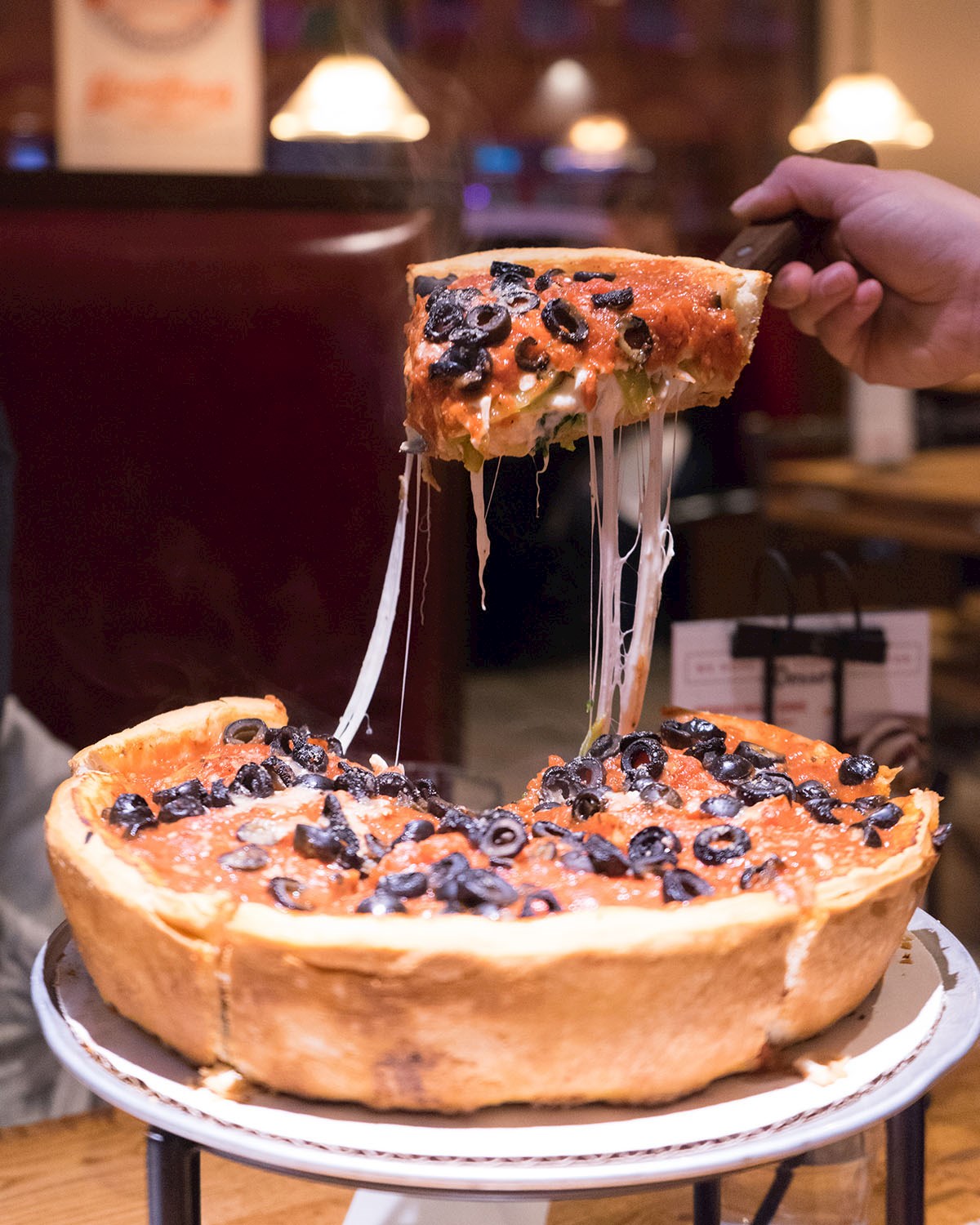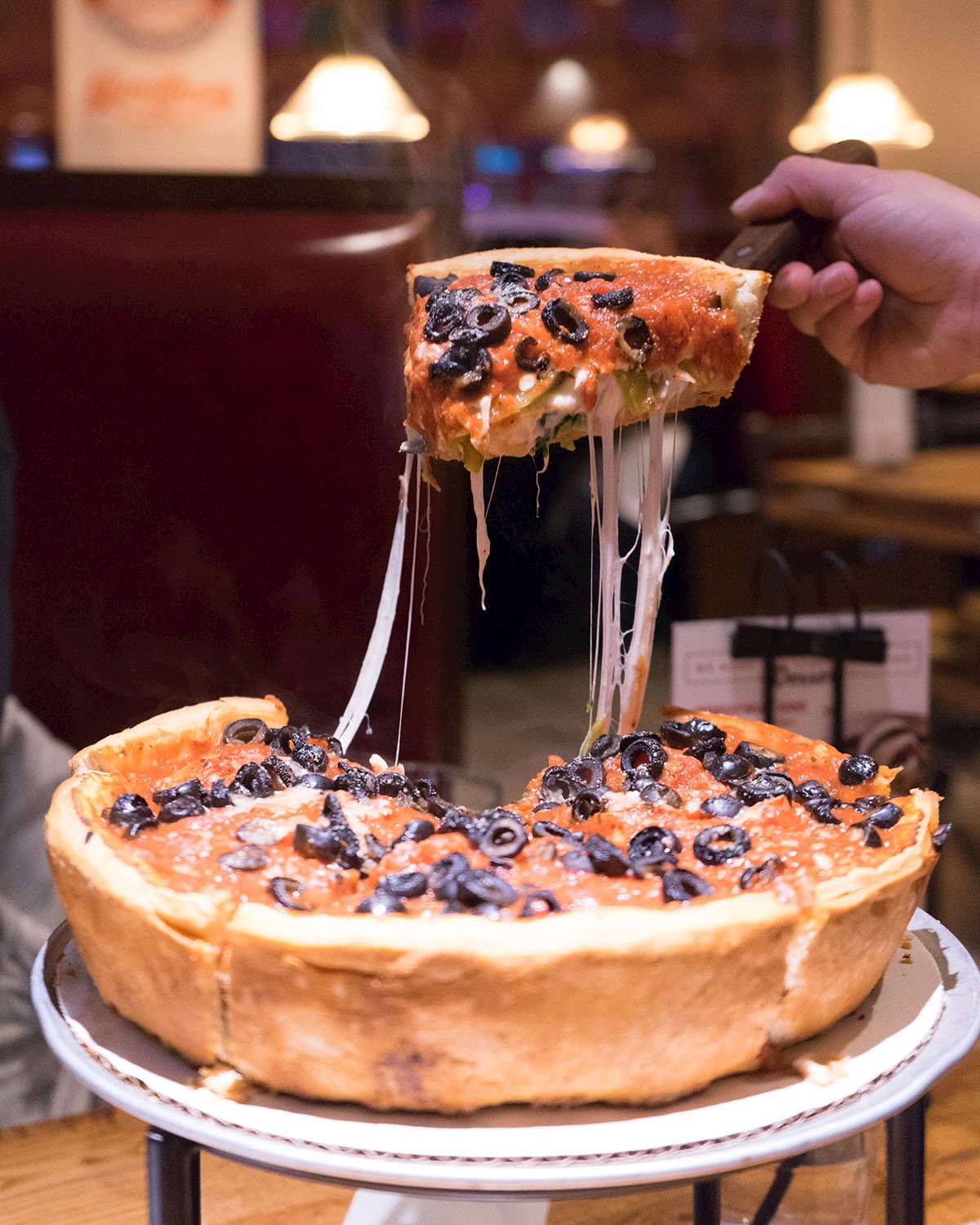In the late 1800s and the early 1900s, Neapolitan immigrants came to the USA in search of a better life. Shortly after, in 1943, their descendants, Ike Sewell and Ric Riccardo had opened Pizzeria Uno in Chicago, serving a new variety of pizza in a deeper dish, with inverted layers of cheese, meat, and tomatoes, and a crunchy crust. While these gentlemen were undoubtedly the driving force behind its commercial success, the culinary mind behind the dish is a bit of a puzzle. Many credit the actual recipe to Rudy Malnati, a chef at Pizzeria Uno during its formative years.
 Pizzeria Uno, original location - Credits: Shutterstock
Pizzeria Uno, original location - Credits: Shutterstock
Diving Deep into the Dish
Visually, the deep-dish pizza is immediately distinguishable. Unlike traditional pizzas that lay flat with toppings glistening on the surface, the deep-dish pizza showcases a high edge, akin to a pie, which encapsulates a medley of ingredients. This elevated crust, often golden brown and buttery, creates a basin, paving the way for generous layers of cheese, toppings, and sauce. While the exterior is crisp, the interior boasts a tender bite, having soaked up the rich flavors from its fillings.
 Pizzeria Uno deep dish pizza - Credits: Pizzeria Uno
Pizzeria Uno deep dish pizza - Credits: Pizzeria Uno
Authentic Chicago-Style Deep Dish Pizza Recipe
The construction of this dish is another delightful deviation from the norm. Unlike the regular sequence on a standard pizza - a thin spread of tomato sauce followed by cheese and then toppings - the deep-dish flips the script. Once the dough is pressed into the pan, a substantial layer of sliced mozzarella forms the base. Following the cheese are toppings, which can range from bell peppers, mushrooms, onions to various meats like sausage, pepperoni, and ground beef. What crowns this assembly is a thick, seasoned tomato sauce, often chunky, that's spread liberally over the top. Some variations even include a sprinkle of parmesan or additional spices on top for that extra zing.

Now, if you're wondering why this inversion in layering, the answer lies in the cooking time. Due to its depth and density, a deep-dish pizza requires a longer time in the oven compared to its thin-crust counterparts. Placing the cheese directly onto the crust ensures that it melts perfectly without getting scorched, while the sauce on top stays juicy and prevents the toppings from drying out.
Taste-wise, every bite of a deep-dish pizza is a flavor explosion. The crust, enriched with butter, is both flaky and tender. The cheese, abundant and gooey, offers a delightful contrast to the tangy and sweet notes of the tomato sauce. The toppings, nestled between these layers, remain succulent, having been slow-cooked between the cheese and the sauce. Each slice is hefty, making it a meal in itself.
The Controversy: Casserole or Pizza?
What began as a singular innovation started gaining momentum. Chicagoans embraced this novel pizza variety, and soon, other establishments wanted a slice of the pie, leading to the proliferation of the deep-dish across the city and later, the country. And with global fame comes great debate. The deep-dish pizza has often found itself in the crosshairs of culinary purists.
 Casserole - Credits: Shutterstock
Casserole - Credits: Shutterstock
Jon Stewart, the former host of "The Daily Show," once famously quipped that "deep-dish pizza is not only not better than New York pizza, it’s not pizza. It’s a [expletive] casserole! Stewart's sentiments, albeit humorously exaggerated, capture a belief held by many pizza purists: that the deep-dish, with its hefty ingredients and pie-like appearance, is closer to a casserole than a pizza.
At a glance, the deep-dish pizza's towering edges and pie-like appearance make it look more like a casserole than a flat, thin pizza. Casseroles are typically deep, layered, and baked in a dish, much like the deep-dish. Their ingredients meld together in harmony, each bite a composite of its constituent layers. The deep-dish, with its crust forming a basin filled with cheese, toppings, and sauce, aligns well with this description. This resemblance is the primary fuel for the 'casserole' camp of the debate.
 Credits: Shutterstock
Credits: Shutterstock
On the other hand, many argue that the essence of a pizza lies in its combination of bread, cheese, and sauce. By that logic, the deep-dish, despite its unconventional approach, remains a pizza at heart.
 Credits: Shutterstock
Credits: Shutterstock
Professional chefs, however, have a range of opinions on the matter. Giuseppe Manco, an Italian pizzaiolo renowned globally, opined, "Each region's pizza is a reflection of its environment, ingredients, and culture. Just because the Chicago deep-dish is vastly different from what I make doesn't mean it isn't pizza." Anthony Bourdain, in one of his culinary explorations, remarked, "It's heavy, it's doughy, it's cheesy. Is it a pizza? I don't know. But I respect it for what it is."
What Makes a Pizza, a Pizza?
The traditional Neapolitan pizza, from which all pizzas trace their lineage, has strict criteria. Originating from Naples, Italy, this pizza is thin with a raised border, a tomato sauce, fresh mozzarella, a drizzle of olive oil, and a few basil leaves. By this stringent definition, many global pizza variations, including some beloved types in Italy itself, wouldn't qualify as 'pizza'.
 Pizza Napoletana Credits: Shutterstock
Pizza Napoletana Credits: Shutterstock
For instance, the Roman-style pizza is thick, almost like focaccia. The New York-style pizza, while thin, is larger, crispier, and loaded with toppings far removed from the Neapolitan simplicity. If we were purists, even these wouldn't qualify as pizzas.
 New York-style pizza - Credits: Shutterstock
New York-style pizza - Credits: Shutterstock
Food, as with all cultural elements, evolves over time, adapting to the tastes, needs, and innovations of regions and eras. The deep-dish pizza is a product of such evolution. It embodies Chicago's spirit - a city renowned for its innovation and refusal to be bound by tradition. When the deep-dish was conceptualized in the 1940s, it was not in defiance of Neapolitan pizza but as an innovation tailored to local preferences. It was pizza reimagined, not pizza replaced.
Embracing the Wide World of Pizza
As with many dishes that have evolved over time, the deep-dish pizza is a testament to innovation and cultural pride. Whether you’re a staunch traditionalist or an adventurous foodie, the deep-dish, with its rich history and richer flavors, demands to be experienced.
 Credits: Shutterstock
Credits: Shutterstock
In the end, to restrict the definition of pizza to just the Neapolitan standard would be like saying only the original apple species can be called an apple, and all its numerous cultivated varieties should get another name. That's not how evolution, adaptation, or indeed, culinary delights work.
The deep-dish, with its crust, cheese, toppings, and sauce, shares the fundamental DNA of a pizza. Its spirit is the same; only its presentation has been adapted. To call it anything but a pizza would be to ignore its heritage, its history, and its place in the pantheon of one of the world's favorite foods.



